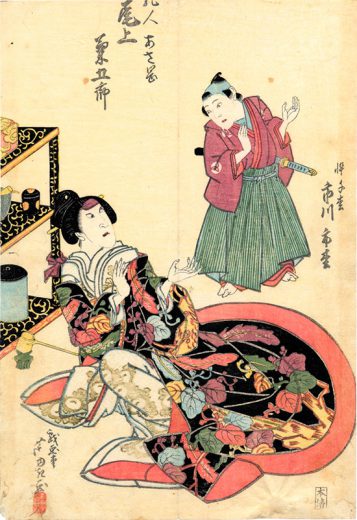Children in Ukiyo-e paintings
June 6 (Tue), 2017 – September 3 (Sun)
This museum exhibits ukiyo-e paintings produced in Osaka in the Edo period. Many of the ukiyo-e paintings made in Osaka were portraits of actors in kabuki plays that were being performed in theatres mainly in Dotombori area.
Kabuki plays are almost always performed by adult male actors, who also play female roles. But there are some plays that main characters are young children, in which they attract the audience with their cuteness or braveness, moving the audience to tears.
In this feature exhibition we focus on children in kabuki plays. Enjoy the ukiyo-e paintings of children playing kabuki and of adults who are always “children” to their parents even after they have grown.

Keisei Date no Nukigaki
Drawn by Gigado Ashiyuki
Portrait of wet nurse Asaoka performed by Onoe Kikugoto III and of boy named Senmatsu performed by Ichikawa Ichimatsu
Children in a pivotal role
In recent years you can see and enjoy many first public appearances and first performances by young sons who are born into a kabuki actor’s family. There are some kabuki plays in which a child appears, and the child’s role is performed by child.
In many kabuki plays in which a child appears, the child’s role is often a pivot of a story and in many cases the story is about love between a parent and a child. Especially in stories that parents sacrifice their sons in order to show their loyalty (such as “parting with son” or “sacrificing of son”), child actors play an important role.
Also in the Edo period, children’s roles were played by children, as depicted in ukiyo-e. Among them, Arashi Kichisaburo III were depicted in ukiyo-e from his early days until his last days.
Ishikawa Goemon and Goroichi
In “Kamagafuchi Futatsu Domoe”, Ishikawa Goemon, a thief, having picked up a missed arrow shot by the lord of Kawachi province during hunting, lies that the arrow hurt Goemon’s mother and takes 50 ryo (monetary unit) for compensation. Goemon spends the money at pleasure district Shimabara, becomes intimate with a prostitute named Takigawa and runs away with her and gets married. One night he, as a thief, crept into a house not knowing his divorced wife Ritsu and son Goroichi live in the house. There Goemon learns that his sibling lost a job because he unlawfully took the 50 ryo. Goemon returns the money and brings Goroichi with him. Present wife Takigawa treats Goroichi harshly with the intention of making the boy running away back to his mother, but after being accused by Takigawa’s father, Goemon and Goroichi are executed by being boiled alive.
Arashi Kichisaburo III Bunka 7 (1810) – Genji 1 (1864)
Son of Arashi Izaburo, who is the first son of Arashi Kichisaburo I and elder brother of Arashi Kichisaburo II. His original name was Daizaburo but took the name of Arashi Kichisaburo III from his uncle in 1821 (Bunka 4). He becomes popular with the support of Arashi Rikan II (Arashi Kitsusaburo II, taking the name from Arashi Kichisaburo II), disciple of Arashi Izaburo and Nakamura Utaemon III.
Inheriting from his uncle(Arashi Kichisaburo II), Arashi Kichisaburo III was a good-looking man and played mainly a leading role. On the other hand, he had a habit of speaking fast and looking aside when playing.
Arashi Kichisaburo had three sons, Rinshi, Izaburo and Torasaburo. He died just after his eldest son Rinshi died young on September 28, 1864 (Genji 1).
“Children” are still “children” even after grown up
To parents, children are still children even after they grow up. In kabuki it depicts complicated emotions between a parent and a child. See how they are in each family.
Fated to be family
Children who you take care since childhood are not only children. When the child gets married, you will have a stepchild. Emotions waver between own and stepchildren, which makes the play dramatic.
Parent-child actors
A son who was born into a kabuki actor’s family is treated as “onzoshi” (son of a distinguished family), and is disciplined from childhood as an heir to succeed the arts and name of the family.
This tradition was already established in the Edo period, and most famous father and son in 19th century are Ichikawa Danjuro VII and Ichikawa Danjuro VIII. Iwai Hanshiro V in this picture had two own sons, Iwai Hanshiro VI and Iwai Matsunosuke (and later took the name Iwai Hanshiro VII).
Sometimes a disciple takes the name by becoming an adopted child: Nakamura Utaemon IV was a disciple of Nakamura Utaemon III and was later adopted. Kataoka Gado II in this picture is an adopted child of Kataoka Nizaemon VII and later took the name of Kataoka Nizaemon VIII. Standing next to him is Kataoka Gato II is also an adopted child of Kataoka Gado II. He posthumously received the name of Kataoka Nizaemon IX.